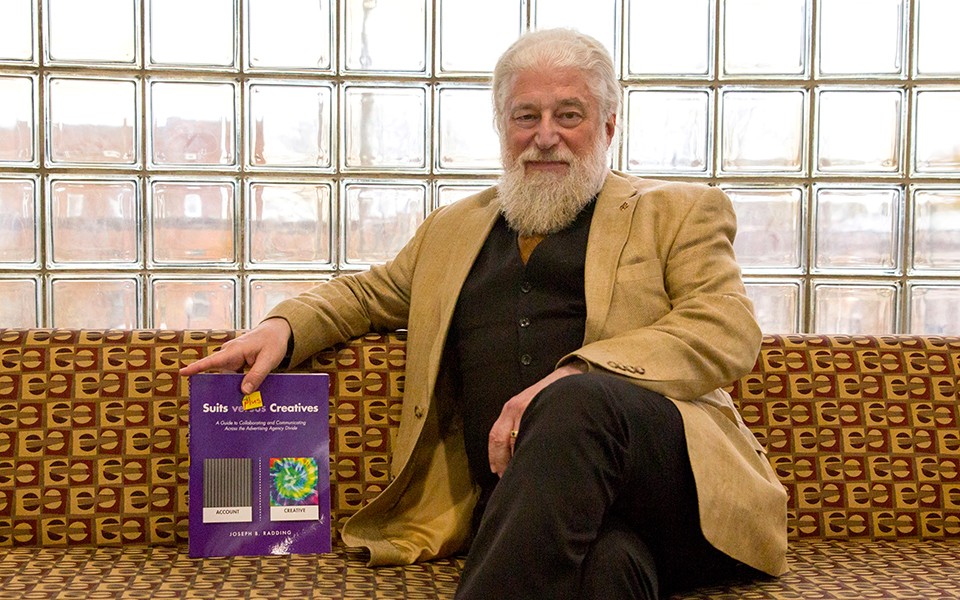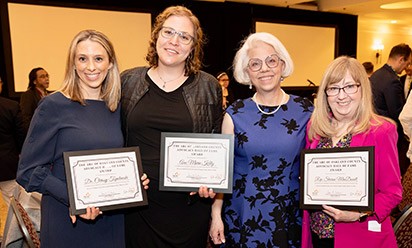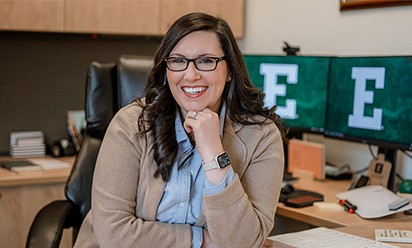COB faculty member's textbook doubles as a problem-solving primer for marketing pros

When starting a career, there’s no substitute for learning the ropes through on-the-job experience. But wouldn’t it be nice if someone gave you a reference guide to resolving the problems you’ll likely encounter?
While your human resources department probably hasn’t produced such a book, Joe Radding has.
Radding, a full-time lecturer in Eastern’s Marketing and Integrated Marketing Communications program, wrote and designed “Suits plus Creatives: A Guide for Collaborating and Communicating Across the Advertising Agency Divide.” The book became available last fall, and Southern Methodist University’s prestigious Temerlin Advertising Institute for Education and Research has adopted it for use in an undergraduate seminar.
The book helps students, educators and professionals in the marketing, marketing communications and advertising fields learn strategies for bridging the divide that often separates account executives (the “suits”) from art directors, graphic designers and copywriters (the “creatives”). Radding uses the book as a supplemental text in his EMU marketing and integrated marketing classes.
“’Suits versus creatives’ is a longstanding trope in the advertising world,” says Radding, who has extensive agency experience in a career spanning more than four decades. “I substituted ‘plus’ for ‘versus’ in the book title because we need to get away from oppositional conflict between the account side and creative teams. The end goals are more satisfied clients and employees.”
Radding began working as a technical illustrator shortly after receiving his bachelor’s degree in Art Theory and Practice from Northwestern University in 1975. That led to graphic design, copywriting, art direction and creative direction for high-profile agency accounts like ACDelco, Northwest Airlines, Ford and Saab. Radding also earned a master’s from EMU in Integrated Marketing. Over the years, he’s seen many instances of the suits/creatives divide.
"Those groups often have a different focus, use different processes and use different jargon,” Radding says. “They also use ‘othering,’ which is a diminishing or dismissing of people in the different group by considering them as ‘others’ rather than part of the team.”
Radding’s book identifies common problems on the account and creative sides and offers solutions based on his work experience. One example features a client that criticized its agency, saying their ad campaign looked like they’d been produced by several different agencies.
“That agency didn’t have a good process for coordinating and integrating its efforts,” Radding says. “The separate divisions didn’t talk to each other or trust each other. So the agency divide can extend beyond the account and creative teams. It could be one division of an agency versus another.”
Radding says internal competition between divisions at Sears ultimately led to the downfall of the once-dominant retail chain, which filed for bankruptcy in mid-October.
“I want students and people working at agencies to recognize when they’re in a bad situation and understand next steps for finding solutions,” Radding says. “I don’t expect students to remember everything in the book, but they can refer back to it when encountering problems in their careers.”
Radding adds that the book’s concepts are cross-disciplinary.
“When I described my book to friends who work in different fields, they recognized similar problems,” he says. “If I can find a collaborator, there’s potential for a series of books.”
In addition to teaching and writing, Radding devotes his energies to multimedia storytelling. He works with select clients on brand identity and positioning, design work and illustration projects. He’s also an active photographer and is painting a series of landscapes based on his trips to Italy. Earlier this year, he co-launched a podcast (The Everyday Knight) dedicated to applying chivalric principles to our modern lives.
“Human capacity is not finite—it expands into the room you make for it,” Radding says. “The more you do, the more you become able to do. That’s the approach I’ve always taken. I encourage people to try lots of different activities. If you find one you enjoy, keep working at it and eventually you’ll become good at it. Learn the process of your discipline, master it and work it. That’s what makes for a successful professional.”
November 14, 2018
Written by:
Jeff Samoray
Media Contact:
Darcy Gifford
dgiffor2@emich.edu
734.487.5375
More Stories

Eastern Michigan University professor recognized on the 2024 Michigan Sports Hall of Fame Ballot for his love of sailing.

Eastern Michigan University professors receive Disability Advocacy Hall of Fame Award from The Arc of Oakland County Michigan.

Eastern Michigan University alumna, Aleksandra Efimova, leads self-made brand, RP to acquisition by renowned industry leader in dance footwear and apparel, Bloch.

Eastern Michigan University Vice President for Enrollment Management Katie Condon-Martin to help shed light on FAFSA “fiasco” as part of Bridge Michigan Zoom discussion on April 24.

Eastern Michigan University awards Summer Research and Creative Activity Grants.

